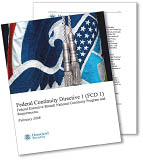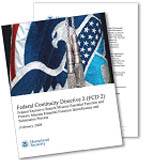The Doctrinal portion of this site highlights the national policy and guidance in which Continuity of Operations initiatives are based. Continuity plans and their supporting Multi-Year Strategy and Program Management Plans provide the framework for the Nation’s Continuity program. Planning addresses the guidance and assistance provided by the Continuity of Operations Division to support Federal Executive Branch departments and agencies, state, territorial, tribal, and local government jurisdictions and private sector organization’s continuity preparedness. Included in this section is an overview of plans and programs designed to support the nation’s continuity programs and the national essential functions.
- National Security Presidential Directive-51/Homeland Security Presidential Directive-20
- National Continuity Policy Implementation Plan
- National Communications System Directive (NCSD) 3-10
- Federal Continuity Directive (FCD) 1
- Federal Continuity Directive (FCD) 2
- Continuity Guidance Circular (CGC) 1
- Continuity Guidance Circular (CGC) 2
National Security Presidential Directive-51/Homeland Security Presidential Directive-20
National Security Presidential Directive-51/Homeland Security Presidential Directive-20 (NSPD-51/HSPD-20) (PDF 33KB, TXT 19KB), National Continuity Policy, issued May 4, 2007, emphasizes the importance of a comprehensive national program involving all government levels and the private sector for integrated and scalable continuity planning. NSPD-51/HSPD-20 prescribes continuity requirements for all executive departments and agencies, and provides continuity guidance for the states, territories, tribal and local governments, and private sector organizations.
This Directive designates the Secretary of Homeland Security as the President’s lead agent for coordinating overall national continuity operations and activities, and provides continuity planners with substantive new guidance designed to enhance the nation’s continuity capabilities. It also directs the Secretary of Homeland Security to assist with the practical implementation of policy guidance through the development and promulgation of continuity planning requirements and guidance for federal and non-federal government jurisdictions and private sector critical infrastructure owners and operators.
National Continuity Policy Implementation Plan
The National Continuity Policy Implementation Plan (NCPIP) (PDF 1MB, TXT 262KB), dated August 2007, provides continuity program implementation guidance for NSPD-51/HSPD-20. It provides directive guidance to assist federal organizations in developing continuity plans and programs, to include the identification of Mission Essential Functions (MEFs) and Primary Mission Essential Functions (PMEFs), that support the eight National Essential Functions (NEFs)—the most critical functions necessary for leading and sustaining our Nation during a catastrophic emergency.
Guidance in the implementation plan helps ensure that our nation’s continuity efforts and resources will be coordinated and leveraged to ensure essential government functions and services will be provided to the nation’s citizens under all conditions. This plan directs more than 75 critical actions to ensure the effectiveness and survivability of our Nation’s continuity capability.
The NCPIP highlights the importance of partnerships with the other branches of the Federal Government, other levels of government, and the private sector to include:
-
Federal Government: Legislative Branch, Executive Branch, and the Judicial Branch
-
State, territorial, tribal, local governments; and
-
Private sector critical infrastructure owners and operators
National Communications System Directive (NCSD) 3-10
National Security Presidential Directive-51/Homeland Security Presidential Directive-20, recognizes the importance of effective communications to meet Enduring Constitutional Government and continuity requirements. The National Communications System Directive (NCSD) 3-10, Minimum Requirements for Continuity Communications Capabilities, establishes a policy framework that defines minimum communications requirements for all Federal Executive Branch organizations and alternate operations facilities, to ensure continuity of national essential functions, as well as assured communication among the President, cabinet officers, and other key executive office personnel. It also assigns specific responsibilities to key executive offices and agencies, defines basic supporting mechanisms, and outlines testing/verifying and reporting requirements.
Federal Continuity Directive (FCD) 1

Federal Continuity Directive 1 (FCD 1) (PDF 2MB, TXT 211KB), Federal Executive Branch National Continuity Program and Requirements, approved by the Secretary of Homeland Security in February 2008, provides operational direction for the development of continuity plans and programs for the Federal Executive Branch. This directive supersedes Federal Preparedness Circular 65 and was developed by NCP’s Continuity of Operations Division in coordination with its interagency partners.
FCD 1 describes the key elements of a viable continuity capability and the importance of coordinating with non-Federal organizations to establish and maintain a comprehensive and effective national continuity capability. Continuity programs and operations are simply good business practices that ensure government functions and services will be available to our nation’s citizens under all conditions.
The provisions of this directive are applicable at all levels of Federal Executive Branch organizations, regardless of their location, and are useful for all non-Federal entities.
The enhancements in the new guidance specifically address the following:
-
Key components of continuity program management, including personnel, communications, and facilities
-
Need for scalable, full-spectrum continuity plans that acknowledge the potential for a broad range of disruptive events and call for more than just a traditional continuity option that requires relocating staff to an alternate facility
-
Incorporation of a risk-based framework for continuity plans and programs to identify and assess potential hazards, determine acceptable levels of risk, and prioritize and allocate resources
-
Inclusion of budgeting considerations in continuity plans and programs
-
Readiness and preparedness considerations.
Federal Continuity Directive (FCD) 2

Federal Continuity Directive 2 (FCD 2) (PDF 1MB, TXT 81KB), Federal Executive Branch Mission Essential Function and Primary Mission Essential Function Identification, approved by the DHS Secretary in February 2008, provides direction and guidance for Federal organizations to identify their essential functions and the business process analysis (BPA) and business impact analysis (BIA) that support and identify the relationships between these essential functions.
FCD 2 provides implementation guidelines for the requirements identified in FCD 1, Annex C. It provides direction and guidance to Federal entities for identification of their mission essential functions (MEFs) and potential primary mission essential functions (PMEFs). It also includes checklists to assist in identifying essential functions through a risk management process and identify potential PMEFs that support specific national essential functions (NEFs)—the most critical functions necessary for leading and sustaining our nation during a catastrophic emergency.
FCD 2 provides direction on the formalized process for submission of a Department’s or Agency’s potential PMEFs that are supportive of the NEFs. It also provides guidance on the processes for conducting a business process analysis (BPA) and business impact analysis (BIA) for each of the potential PMEFs that help identify essential function relationships and interdependencies, time sensitivities, threat and vulnerability analyses, and mitigation strategies affecting and supporting the PMEFs.
Continuity Guidance Circular (CGC) 1

Continuity Guidance Circular 1 (CGC 1) (PDF 918KB, TXT 177KB), Continuity Guidance for Non-Federal Entities (States, Territories, Tribal, and Local Government Jurisdictions and Private Sector Organizations), was approved by the FEMA Administrator on January 21, 2009. CGC 1 supersedes the Interim Guidance on Continuity of Operations Planning for State and Local Governments, and provides operational guidance for implementing NSPD-51/HSPD-20 for non-Federal entities. CGC 1 provides guidance for developing continuity plans and programs for the sustainment of essential functions and services to our nation’s citizens, under all conditions.
Continuity Guidance Circular (CGC) 2
Continuity Guidance Circular 2 (CGC 2) (PDF 4.1MB, TXT 94KB), Continuity Guidance for Non-Federal Entities: Mission Essential Functions Identification Process (States, Territories, Tribes, and Local Government Jurisdictions), was approved July 22, 2010, by the Assistant Administrator of National Continuity Programs. CGC 2 provides planning guidance to assist non-Federal entities and organizations in identifying their essential functions. Additionally, CGC 2 describes the use of a systematic Business Process Analysis, Business Impact Analysis, and the development of risk mitigation strategies.

